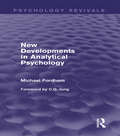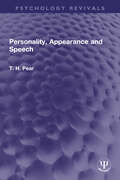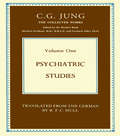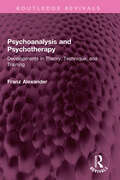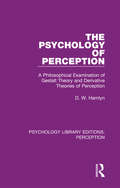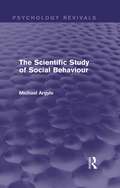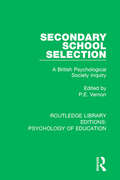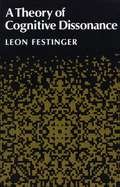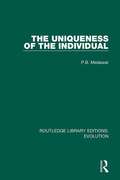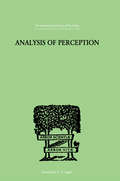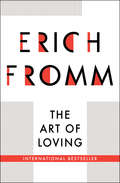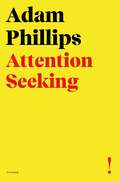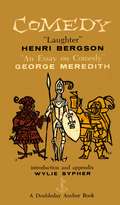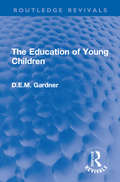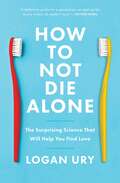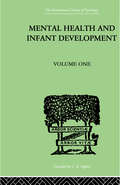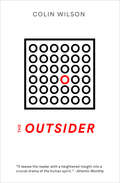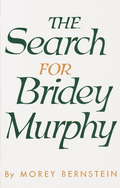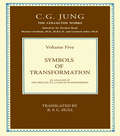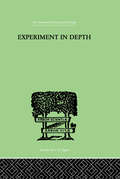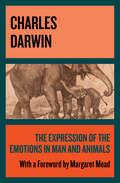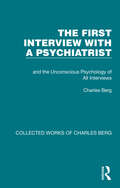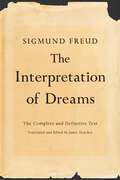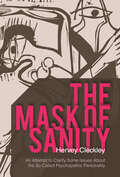- Table View
- List View
New Developments in Analytical Psychology (Psychology Revivals)
by Michael FordhamOriginally published in 1957, New Developments in Analytical Psychology built on the work of C.G. Jung. Jung’s researches into the unconscious had led him to study the history of religion and the hitherto little understood psychology of alchemy; they had directed him away from child psychology and also, in later years, away from clinical analysis as well. Nonetheless his discoveries and theories have essential relevance in both these spheres. All the papers in this volume complement and amplify Jung’s work. The author made a special study of child analysis and ego development and here publishes his conclusions in a series of papers. The studies of children led to developments in analytic techniques which are worked out in a longer essay on the transference, to the understanding of which analytical psychology has a unique contribution; they have also stimulated a reassessment of the relation between the concept of archetypes and modern theories of heredity, instinct, neuro-physiology, and evolution, in which there had been much misunderstanding at the time. Michael Fordham was the last of the founders of a movement in psychoanalysis, and pioneered the Jungian analysis of children. This significant, early work can now be read and enjoyed in its historical context.
Personality, Appearance and Speech (Routledge Revivals)
by T. H. PearFirst published in 1957, Personality. Appearance and Speech is an intensive analysis of personality reflected by appearance and speech. It is a most fascinating study of the innumerable outward signs by which the man in the street judges personality. The author considers the effects this has on daily life; for example, can a person’s real character be assessed by a short interview in which personality, counting for so much, can be altered deliberately to no little extent? He describes many investigations which have attempted to discover experimentally the nature and accuracy of personality and character assessments, and includes personality sketches of F. D. Roosevelt, W. E. Gladstone, and of other prominent figures. He discusses the social results of the microphone and the effect on good and bad taste, of opinions widely expressed by listeners and viewers. The nature and function of the intellectuals who have increasing opportunities of affecting appearance and speech, are examined from the psychologist’s standpoint. This book will be of interest to students of psychology, sociology and social behaviour.
Psychiatric Studies: Experiments In The Diagnosis Of Psychopathological Conditions Carried Out At The Psychiatric Clinic Of The University Of Zurich (classic Reprint) (Collected Works of C.G. Jung #No. 20)
by C.G. JungAt the turn of the last century C.G. Jung began his career as a psychiatrist. During the next decade, three men whose names are famous in the annals of medical psychology influenced his professional development: Pierre Janet, under whom he studied at the Sappetriere Hospital in Paris; Eugen Bleuler, his chief at the Burgholzli Mental Hospital in Zurick; and Sigmund Frued, whom Jung met in 1907. It is Bleuler, and to a lesser extent Janet, whose influence is to be found in the descriptive experimental psychiatry composing Volume I of the Collected Works. These papers appeared between 1902 and 1905l most of them are now being published in English for the first time. The volume opens with Jung's dissertation for the medical degree: 'On the Psychology and Pathology of So-Called Occult Phenomena', a study that foreshadows much of his later work, and as such is indispensable to all serious students of his work. It is the detailed analysis of the case of an hysterical adolescent girl who professed to be a medium. The volume also includes papers on cryptomnesia, hysterical parapraxes in reading, manic mood disorder, simulated insanity, and other subjects.
Psychoanalysis and Psychotherapy: Developments in Theory, Technique, and Training (Psychology Revivals)
by Franz AlexanderFirst published in 1957 Psychoanalysis and Psychotherapy summarizes and evaluates the trends in this field in the 1950s. By 1950s important changes have taken place as a result of growing acceptance of psychoanalysis by the medical community. More and more we realize the great possibilities of applying the knowledge gained from psychoanalysis to psychotherapy. What is called ‘dynamically oriented psychotherapy’ with its less complete and less intensive treatment can greatly benefit large group of patients. Dr Alexander illuminates interesting points of theory, discusses controversial issues, and offers views- his own and those of others- on questions of psychiatric training both in psychoanalytic institutes and in medical schools. This comprehensive book is a must read for everyone concerned with the urgent problem of mental health.
The Psychology of Perception: A Philosophical Examination of Gestalt Theory and Derivative Theories of Perception (Psychology Library Editions: Perception #13)
by D. W. HamlynOriginally published in 1957, the primary aim of this study was to shed light upon the logical character of the psychology of perception. D.W. Hamlyn begins by delimiting the field of psychological inquiry into perception, then gives a detailed account of the types of explanation appropriate in the field. He maintains that these explanations have certain important peculiarities which distinguish them from other scientific inquiries. In view of the central importance of Gestalt Theory in this field an account is given of its origins, and its main features are critically discussed. The work should still be of considerable interest to both philosophers and psychologists, as well as to all those interested in the relations between the two subjects.
The Scientific Study of Social Behaviour (Psychology Revivals)
by Michael ArgyleOriginally published in 1957, this book presented an up-to-date account of psychological research into human social behaviour of the time. There are chapters on interaction between pairs of people, behaviour in small social groups, and human relations in industry. The author avoided the adoption of any particular theoretical position, and concentrated on the established empirical findings of the time. The results of several hundred investigations are summarised and compared, so that the principal generalisations which emerge can be seen. Stress is placed on rigorous methods of research, and a critical account is given of current techniques of social research, showing the importance of experimental and statistical methods. Careful consideration is given to the danger of the investigator disturbing what is being investigated. Use is made of recent ideas about theory and explanation, and the different kinds of theory used in experimental psychology were considered for the first time as possible ways of accounting for group behaviour. This book was intended not only for students of psychology and of the other social sciences, but also for industrialists, administrators and indeed all who were interested in the laws underlying social behaviour. Today it can be read and enjoyed in its historical context.
Secondary School Selection: A British Psychological Society Inquiry (Routledge Library Editions: Psychology of Education)
by P. E. VernonSelection for secondary education at 11-plus still arouses widespread controversy; and the psychological techniques which are employed, such as intelligence and attainments tests, are often criticised. Originally published in 1957, under the auspices of the British Psychological Society, a group of psychologists, experienced in this field, tried to present a balanced survey of the situation at the time. They show that the real problems of secondary schooling cannot be solved by simple administrative changes; they arise from historical causes, from the class structure of English society and the educational and vocational ambitions of parents. Psychology has studied the development and differentiation of children’s abilities and interests with age, and thus throws light on the need for, and the consequences of, streaming children in different classes or schools, and the value of alternative systems such as the comprehensive school. Selection at 11-plus, it is admitted, does have harmful effects on teaching in the junior school and produces much emotional strain, though these effects are often exaggerated. It was, in fact, accurate for some ninety per cent of children; yet the implications of its inevitable inaccuracy for some pupils cannot be ignored. The functions, and the value, of intelligence and attainments tests and the essay are examined, and full consideration given to the use of teachers’ estimates of suitability and other techniques. The Report is addressed primarily to teachers, educational administrator, and psychologists – that is people with some background knowledge of the problems involved; but it should also be intelligible and helpful to the educated layman, since the more technical details are confined to Appendices.
A Theory Of Cognitive Dissonance
by Leon FestingerLeon Festinger's theory of cognitive dissonance has been widely recognized for its important and influential concepts in areas of motivation and social psychology. The theory of dissonance is here applied to the problem of why partial reward, delay of reward , and effort expenditure during training result in increased resistance to extinction. The author contends that a state of impasse exists within learning theory largely because some of its major assumptions stand in apparent opposition to cetain well-established experimental results. The book puts forward a new theory that seems to reconcile these data and assumptions. This new theory can account for data with which other theories have difficulty: it integrates empirical phenomena that have been regarded as unrelated, and it is supported by the results of experiments designed specifically to test its implications. These experiments are fully described in the text.
The Uniqueness of the Individual (Routledge Library Editions: Evolution #8)
by P.B. MedawarOriginally published in 1957, The Uniqueness of the Individual is a collection of 9 essays published from the ten years preceding publication. The essays deal with some of the central problems of biology. These are among the questions put and answered from the standpoint of modern experimental biology. What is ageing and how is it measured? What theories have been held to account for it, and with what success? Did ageing evolve, and if so how? Is Lamarckism and adequate explanation of evolutionary process? Does evolution sometimes go wrong? Do human beings evolve in a way peculiar to themselves? Other essays touch upon the problems of scientific method and of growth and transformation. This book will be of interest to natural historians, evolutionists and anthropologists.
Analysis Of Perception (International Library Of Psychology Ser.)
by Smythies, J RFirst published in 1999. Routledge is an imprint of Taylor & Francis, an informa company.
The Art of Loving (Classics Of Personal Development Ser.)
by Erich FrommThe international bestseller that launched a movement with its powerful insight: "Love is the only sane and satisfactory answer to the problem of human existence."The Art of Loving is a rich and detailed guide to love--an achievement reached through maturity, practice, concentration, and courage. In the decades since the book's release, its words and lessons continue to resonate. Erich Fromm, a celebrated psychoanalyst and social psychologist, clearly and sincerely encourages the development of our capacity for and understanding of love in all of its facets. He discusses the familiar yet misunderstood romantic love, the all-encompassing brotherly love, spiritual love, and many more. A challenge to traditional Western notions of love, The Art of Loving is a modern classic about taking care of ourselves through relationships with others. This ebook features an illustrated biography of Erich Fromm including rare images and never-before-seen documents from the author's estate.
Attention Seeking
by Adam PhillipsAttention Seeking is a short, fascinating introduction to the concept of attention from Britain’s leading psychoanalyst, author of Missing Out and On Kindness.Everything depends on what, if anything, we find interesting: on what we are encouraged and educated to find interesting, and what we find ourselves being interested in despite ourselves. There is our official curiosity and our unofficial curiosity (and psychoanalysis is a story about the relationship between the two).Based on three connected lectures by Adam Phillips, this compact book is a lucid and memorable introduction to the concept of our attention, spanning from interest to obsession, private desire to corporate commodity. What is attention, and why do we seek it? How does our culture moralize attention as a force in need of control? Phillips is one of our brightest and most unusual thinkers, uniquely capable of bringing our deepest impulses and instincts to light.
Comedy: An Essay on Comedy
by George Meredith Henri Bergson Wylie SypherWhen she has frolicked through her five Acts to surprise you with the information that Mr. Aimwell is converted by a sudden death in the world outside the scenes into Lord Aimwell, and can marry the lady in the light of day, it is to the credit of her vivacious nature that she does not anticipate your calling her Farce.
The Education of Young Children (Routledge Revivals)
by D.E.M. GardnerFirst published in 1956, The Education of Young Children is focused on presenting the psychological needs of children within education, following several talks given by the author at conferences for teachers of young children. The book highlights the importance of meeting all aspects of a child’s needs. It demonstrates that physical, emotional, social, and intellectual needs are all intrinsically connected and fundamental to education and development. It also puts forward the significance of Nursery Schools and the training given to Nursery School teachers, as well as the influence of Nursery Schools on Infant Schools. The Education of Young Children will appeal to those with an interest in the history and psychology of education.
How to Not Die Alone: The Surprising Science That Will Help You Find Love
by Logan UryA &“must-read&” (The Washington Post) funny and practical guide to help you find, build, and keep the relationship of your dreams.Have you ever looked around and wondered, &“Why has everyone found love except me?&” You&’re not the only one. Great relationships don&’t just appear in our lives—they&’re the culmination of a series of decisions, including whom to date, how to end it with the wrong person, and when to commit to the right one. But our brains often get in the way. We make poor decisions, which thwart us on our quest to find lasting love. Drawing from years of research, behavioral scientist turned dating coach Logan Ury reveals the hidden forces that cause those mistakes. But awareness on its own doesn&’t lead to results. You have to actually change your behavior. Ury shows you how. This &“simple-to-use guide&” (Lori Gottlieb, New York Times bestselling author of Maybe You Should Talk to Someone) focuses on a different decision in each chapter, incorporating insights from behavioral science, original research, and real-life stories. You&’ll learn: -What&’s holding you back in dating (and how to break the pattern) -What really matters in a long-term partner (and what really doesn&’t) -How to overcome the perils of online dating (and make the apps work for you) -How to meet more people in real life (while doing activities you love) -How to make dates fun again (so they stop feeling like job interviews) -Why &“the spark&” is a myth (but you&’ll find love anyway) This &“data-driven&” (Time), step-by-step guide to relationships, complete with hands-on exercises, is designed to transform your life. How to Not Die Alone will help you find, build, and keep the relationship of your dreams.
Mental Health And Infant Development: Volume One: Papers and Discussions
by Kenneth SoddyThis is Volume XXVII of thirty-two of a series on Developmental Psychology. Originally published in 1956, this is part one(papers and discussions) of two on mental health and infant development, and is the proceedings of the International Seminar held by the World Federation of Mental Health at Chichester, England.
The Outsider: A Study Of Sexual Outsiders (Picador Bks. #Vol. 6)
by Colin WilsonAs relevant today as when it originally published, THE OUTSIDER explores the mindset of characters who exist on the margins, and the artists who take them there. Published to immense acclaim, THE OUTSIDER helped to make popular the literary concept of existentialism. Authors like Sartre, Kafka, Hemingway, and Dostoyevsky, as well as artists like Van Gogh and Nijinsky delved for a deeper understanding of the human condition in their work, and Colin Wilson’s landmark book encapsulated a character found time and time again: the outsider. How does he influence society? And how does society influence him? It’s a question as relevant to today’s iconic characters (from Don Draper to Voldemort) as it was when initially published. Wilson’s seminal work is a must-have for those who love books and are fascinated by that most difficult to understand of characters.
The Search for Bridey Murphy
by Morey BernsteinThe story of Ruth Simmons, who while under hypnosis recants the story of the life of Bridey Murphy under the care of one of the leading hypnotherapist of the day.
THE COLLECTED WORKS OF C. G. JUNG: Symbols Of Transformation (Collected Works of C. G. Jung #46)
by C.G. JungIn 1911 Jung published a book of which he says: '...it laid down a programme to be followed for the next few decades of my life.' It was vastly erudite and covered innumerable fields of study: psychiatry, psychoanalysis, ethnology and comparitive religion amongst others. In due course it became a standard work and was translated into French, Dutch and Italian as well as English, in which language it was given the well-known but somewhat misleading title of The Psychology of the Unconscious. In the Foreword to the present revised edition which first appeared in 1956, Jung says: '...it was the explosion of all those psychic contents which could find no room, no breathing space, in the constricting atmosphere of Freudian psychology... It was an attempt, only partially successful, to create a wider setting for medical psychology and to bring the whole of the psychic phenomena within its purview.' For this edition, appearing ten years after the first, bibliographical citations and entries have been revised in the light of subsequent publications in the Collected Works and in the standard edition of Freud's works, some translations have been substituted in quotations, and other essential corrections have been made, but there have been no changes of substance in the text.
Becoming: Basic Considerations for a Psychology of Personality
by Gordon W. AllportAllport outlines the need for a psychology of becoming, of growth and development of personality, one that can best be discovered by looking within ourselves.
Experiment In Depth: A STUDY OF THE WORK OF JUNG, ELIOT AND TOYNBEE (International Library Of Psychology Ser.)
by Martin, P WFirst published in 1999. Routledge is an imprint of Taylor & Francis, an informa company.
The Expression of the Emotions in Man and Animals
by Charles DarwinWith a foreword by Margaret Mead: Darwin examines genetically determined behavior, combining the science of evolution with insights into human psychology.Published in 1872, thirteen years after On the Origin of Species, The Expression of the Emotions in Man and Animals is devoted to documenting what Darwin believes is the genetically determined aspects of behavior. Together with The Descent of Man (1871), it sketches out Darwin&’s main thesis of human origins. Here he traces the animal origins of human characteristics such as pursing of the lips in concentration, tightening of the muscles around the eyes in anger and efforts of memory. Darwin&’s thesis is that if the outward signs of behavior and emotions are shown to be universal in man and similar to animals then they must be due to inherited evolutionary adaptation, not culturally acquired characteristics. Several British psychiatrists, in particular James Crichton-Browne, were consultants for the book, which forms Darwin&’s main contribution to psychology. Darwin&’s collection of detailed observations along with his acute observational abilities and pictures (a landmark in the history of illustrations within the body of the text) corroborate his thesis and form the basis of the book. The foreword by Margaret Mead is of great interest in and of itself. Her foreword, illustrated with pictures provided by her, is designed to subvert Darwin&’s chief idea. Paul Ekman, a later editor of this same work, &“wonder[s] how Darwin would have felt had he known that his book was introduced by a cultural relativist who had included in his book pictures of those most opposed to his theory.&”
The First Interview with a Psychiatrist: and the Unconscious Psychology of All Interviews (Collected Works of Charles Berg)
by Charles BergOriginally published in 1955, the blurb read: 'Again in this book the author expounds his main thesis – perhaps the main thesis of all modern psychiatry – namely that our conscious pre-occupations, thoughts and behaviour are merely the products or "symptoms" of a process that is going on within us (basically a physiological process) of which we are totally unconscious. Although we are at pains to conceal from ourselves and others, and even vehemently to deny, the nature and the very existence of this fundamental unconscious process, it is nevertheless the determinant of all that is us, biologically, psychologically and sociologically. In the author’s own words: "It is the force behind all activity, all life. It exists unseen in the most apparently superficial human relationship, even in the interview – as this book will show. It alone can give us the meaning of what we do and feel." The theoretical section of the book deals with the interviewer and the unconscious forces which determine the effects and the therapeutic results of the interview. The longer practical section demonstrates, by abundant examples from clinical material and by complete documentaries of actual psychiatric interviews, that it is unconscious forces which determine the patient’s symptomatic picture, his behaviour, his attitude to life, and above all his emotional relationship to the psychiatrist – and indeed to everyone he meets in every personal contact. The elucidation of this process should be of the utmost interest and of the utmost practical value to each of us in our every contact, superficial or deep, with every human being whom we meet in the course of our lives. The book will appeal to a wide public. Although it demonstrates the deepest and most worthwhile aspect of modern psychology and psychiatry, it avoids technical jargon and is written in a cheerful, lively and lucid style, easily assimilable by everybody.' Today it can be read and enjoyed in its historical context. This book is a re-issue originally published in 1955. The language used is a reflection of its era and no offence is meant by the Publishers to any reader by this re-publication.
The Interpretation of Dreams: The Complete and Definitive Text
by Sigmund Freud James StracheyWhat are the most common dreams and why do we have them? What does a dream about death mean? What do dreams of swimming, failing, or flying symbolize? First published by Sigmund Freud in 1899, The Interpretation of Dreams considers why we dream and what it means in the larger picture of our psychological lives. Delving into theories of manifest and latent dream content, the special language of dreams, dreams as wish fulfillments, the significance of childhood experiences, and much more, Freud, widely considered the "father of psychoanalysis,” thoroughly and thoughtfully examines dream psychology. Encompassing dozens of case histories and detailed analyses of actual dreams, this landmark text presents Freud’s legendary work as a tool for comprehending our sleeping experiences. Renowned for translating Freud’s German writings into English, James Strachey--with the assistance of Anna Freud--first published this edition in 1953. Incorporating all textual alterations made by Freud over a period of thirty years, it remains the most complete translation of the work in print. Completely redesigned and available for the first time in trade paperback
The Mask of Sanity: An Attempt to Clarify Some Issues about the So-Called Psychopathic Personality
by Hervey CleckleyThe classic that has transformed the psychiatric definition of sanity and continues to provide insight on American society and psychological introspection.Although highly controversial, Hervey Cleckley&’s Mask of Sanity provides one of the most influential clinical descriptions of psychopathy in the twentieth century. At the crux of his argument, Cleckley claims that many psychopathic personalities go undiagnosed because they maintain a social mask that conceals their mental disorder and enables them to blend in with society. Furthermore, many of these affected individuals appear to function normally in accordance with standard psychiatric criteria.Intent on detecting and diagnosing the elusive psychopath, Cleckley has compiled an assortment of case studies and offers suggestions for palliative care. This ambitious work aims to define and examine every aspect of this abstract state of being. Ultimately, Cleckley refines the term &“psychopath&” and strips it of stigmatization.&“I know of no more stirring presentation of the clinical picture, the social consequences, and the therapeutic difficulties incident to the problem of the psychopath.&” —The Quarterly Review of Biology
